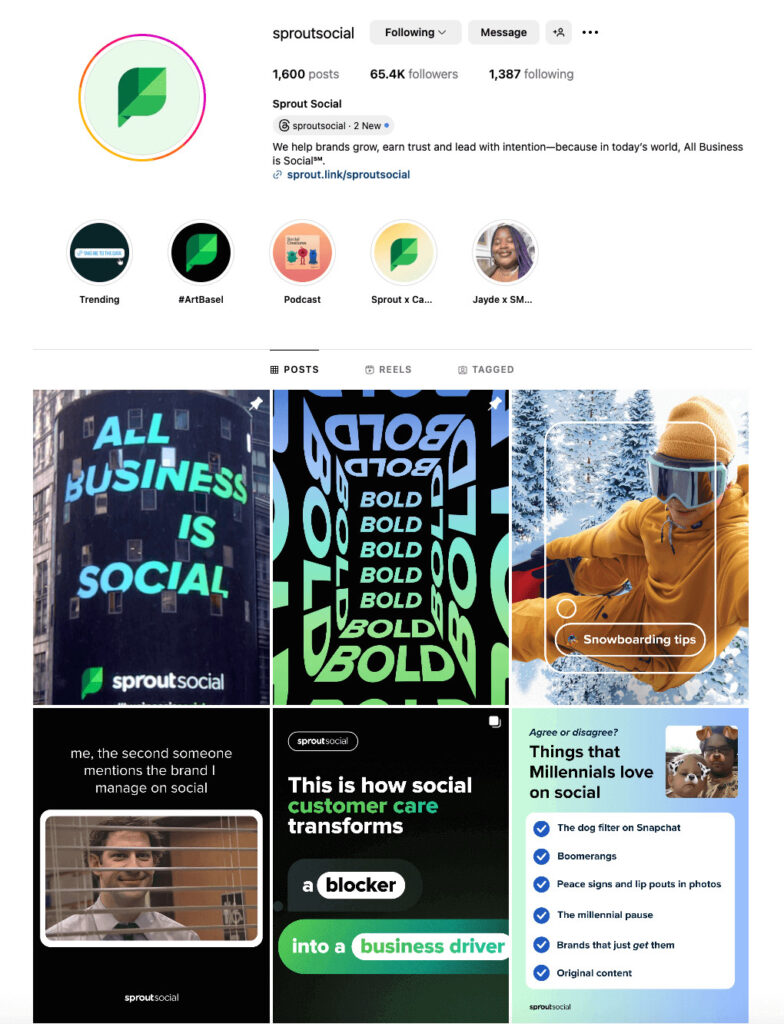Ever come across an Instagram brand account that sees almost zero interactions? From the looks of it, they already have a solid Instagram marketing strategy in place. Their profile is optimized, they’re posting regularly and their content looks great. So why the crickets?
Growing competition on the platform is a major reason. With users seeing a constant stream of content filling their Feeds, it takes a lot more to get their attention. And the 2025 Sprout Social Index™ confirms that consumers are expecting more from brands on social. Strategies like posting constantly (just for the sake of it) and jumping in on every trend are no longer going to cut it.
Brands need to be more intentional, more original and more responsive with their Instagram efforts. That’s why we put together this comprehensive guide of the Instagram best practices to take your strategy to the next level. Let’s get started.
Instagram content best practices
Content is the backbone of your Instagram strategy. It’s what you need to get your message across and engage your audience. Without a strong content strategy to back you up, everything else will fall apart.
Let’s explore some Instagram best practices on creating content that drives results.
1. Produce visually compelling and on-brand content
Visuals are everything on a platform like Instagram. A badly photographed image or a poorly designed graphic isn’t going to cut it. You need high-quality images and videos that stand out and instantly attract your audience.
Beyond visual appeal, focus on creating original and entertaining content to humanize your brand. If the 2025 Sprout Social Index™ taught us anything, it’s that consumers value these elements in a brand’s social media content. Authenticity and relatability are among the top brand content traits for these consumers.
Make sure to cohesively tie up your visuals with the strategic use of colors and filters. So your images not only look great but also give a consistent look and feel to your entire Instagram page. Ideally, you should stick to color combinations and visual styles that fit your brand identity.
Sprout’s signature blues and greens are instantly noticeable when you visit our Instagram page.
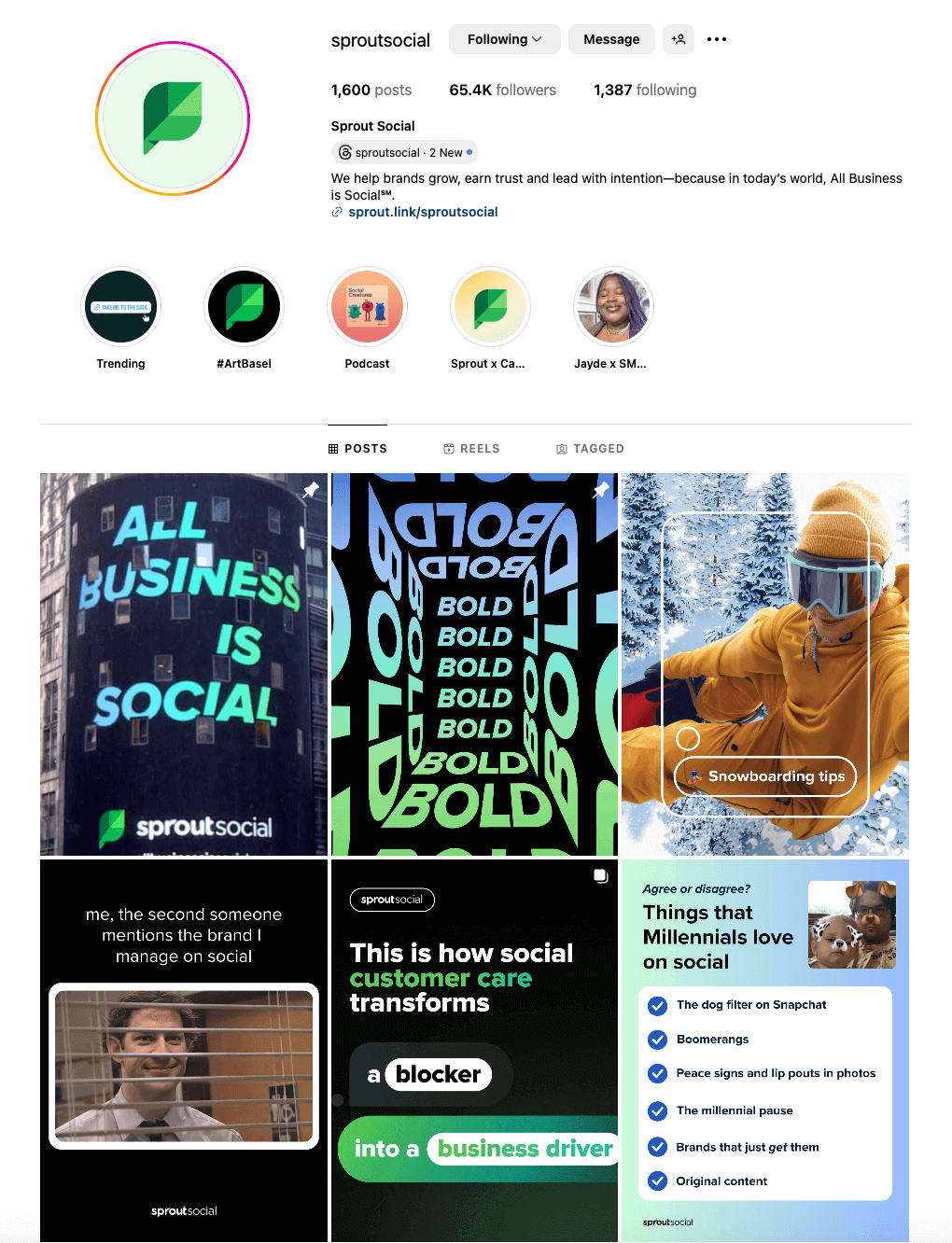
2. Tell visual stories through Reels and carousels
For your brand to leave a lasting impact, it has to be memorable. And that’s where storytelling comes in. With tools like Reels and carousels, Instagram gives you the perfect place to share captivating visual stories.
Follow Instagram Reels best practices like using trending audio to make your Reels discoverable. Add a strong hook in the first three seconds to grab attention. And keep your content short and engaging so viewers are more likely to watch till the end.
While trends are a great way to drive visibility with Reels and carousels, there’s also such a thing as blindly jumping on every trend. Our 2025 Index™ found that this doesn’t always bode well with consumers today. Instead, consumers want brands to be culturally competent and to keep up with online culture.
This involves adapting to the growing shift toward intentional and uplifting content. According to the Q2 2025 Sprout Social Pulse Survey, consumers expect brands to be honest and inspirational.
Younger generations are actively curating their feeds for positive content and community bonding. They’re no longer perceiving social media as a “time suck” or a place for impulse purchases. This suggests brands should provide valuable, informative or uplifting content on Instagram. “Edutainment” content tops the list of content types users seek out on social media.
Tell engaging stories about your brand history and its impact. Humanize your brand through inspirational customer stories and uplifting employee experiences. Patagonia tells some of the most engaging brand stories through Reels and carousels. These posts feature stories of real changemakers and the brand’s environmental impact.
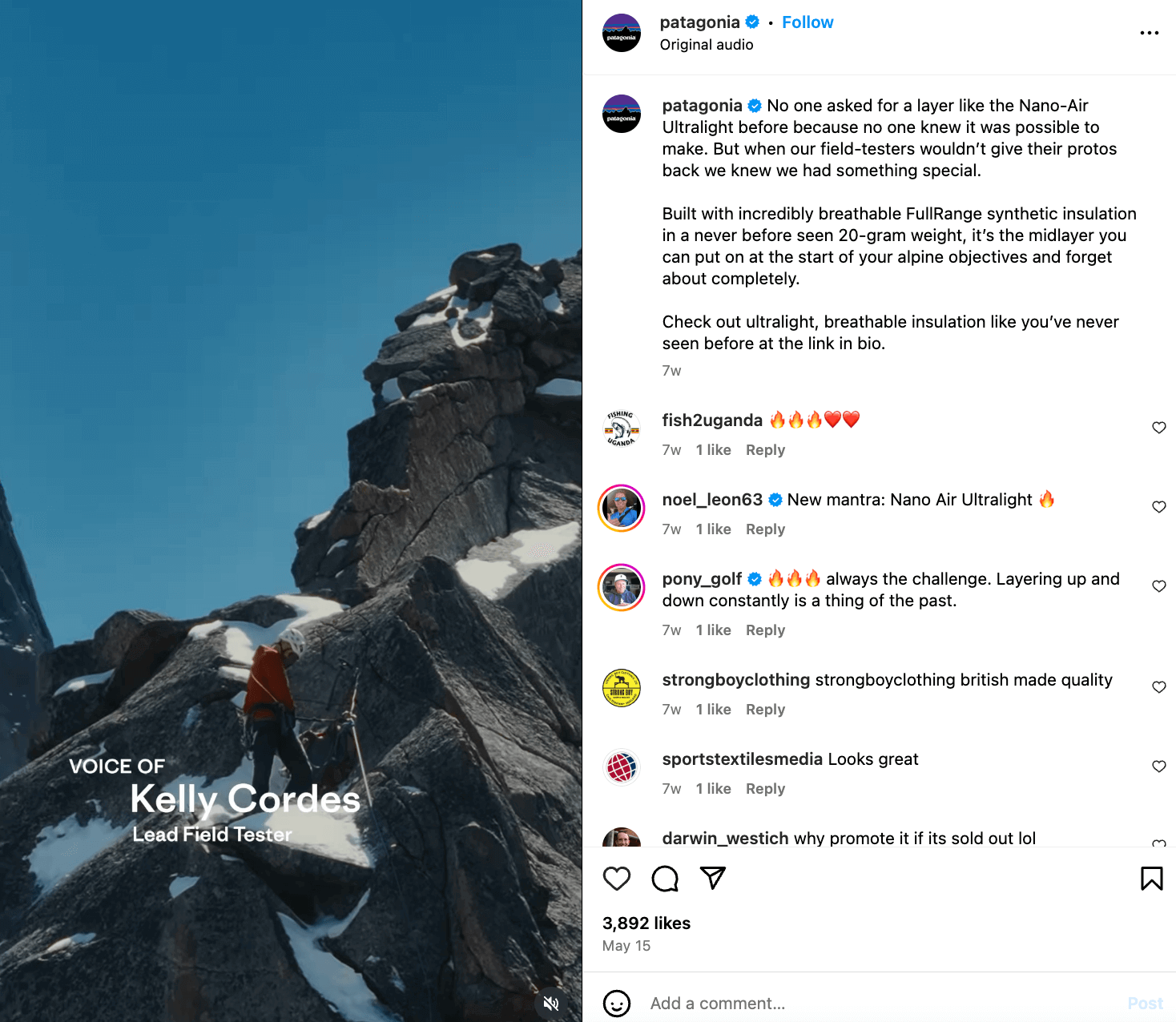
3. Build trust with user-generated content (UGC)
User-generated content, or UGC, is the content that customers organically share about your brand. Think: detailed reviews of their positive experience or posts featuring your product. This type of content serves as a powerful form of social proof as it shows others that people are vouching for your brand.
UGC also shows your products in real-life scenarios, adding authenticity and relatability. With all these factors considered, it’s highly effective for building trust with your audience.
Chewy regularly reposts UGC from pet parents. This helps connect the brand community through hilarious experiences and relatable content.
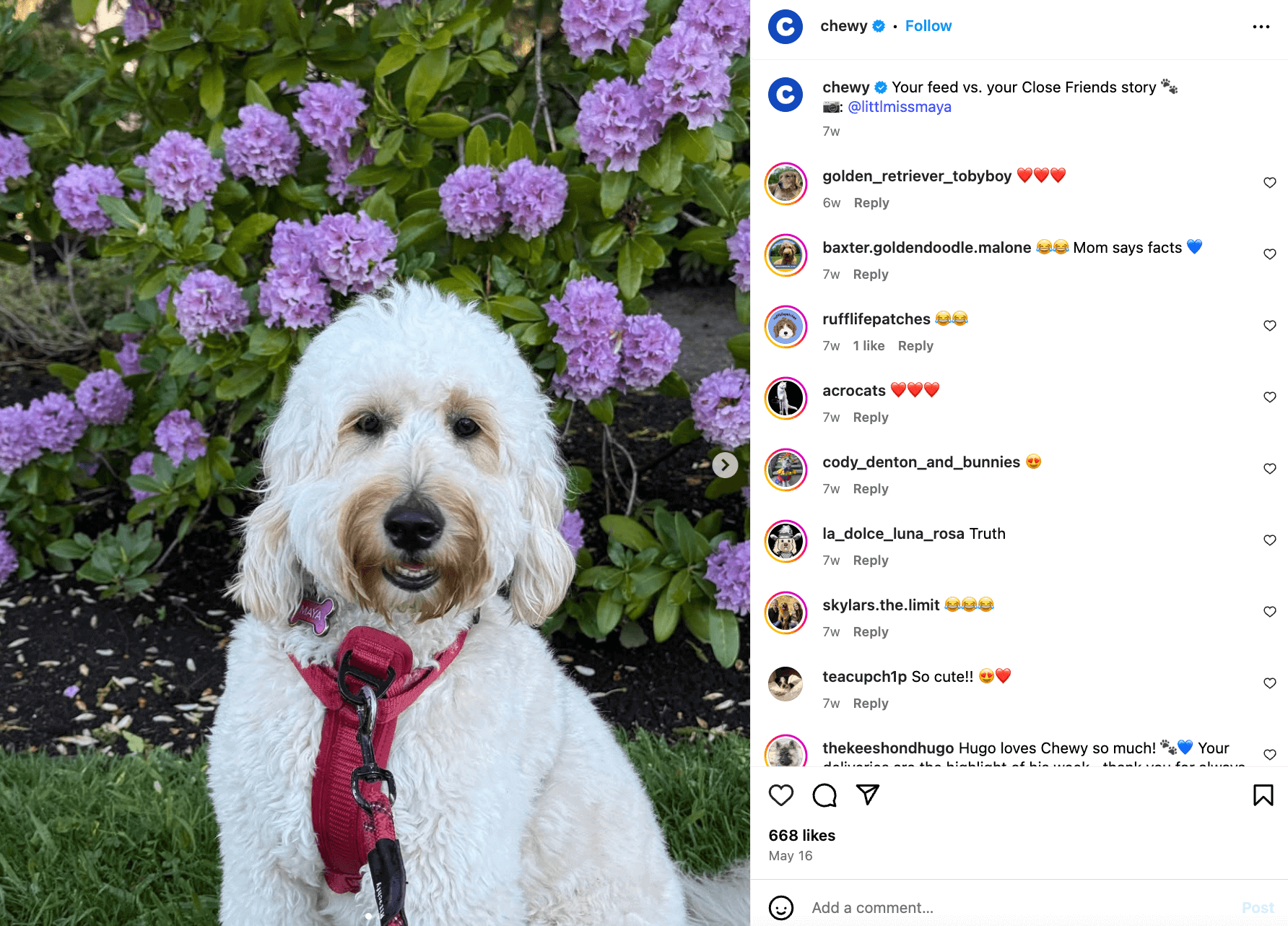
Create branded hashtags and encourage customers to use them to share their stories. Then repurpose the content for your Instagram Feed or Stories, depending on what works for you.
Use Sprout’s Social Listening tools to keep track of social conversations around your brand or product. The platform lets you set up hashtag tracking, so you can scour through Instagram captions that use relevant hashtags. It even lets you set up listening to focus on conversations that mention specific campaigns.

4. Test and diversify your content formats
It’s the age of short-form video, and it’s no different on Instagram. The 2024 Social Media Content Strategy Report proves just that. Users are most likely to interact with short-form video that’s shorter than 15 seconds.
But don’t rule out static images just yet, because they still see the second-highest interactions. Longer short-form video (15-60 seconds) ranks third among the top-performing Instagram content types. This indicates that brands need to test out different content formats to see what works best instead of sticking to one format.
5. Drive interaction with contests, games and challenges
Users love the opportunity to interact with brands. So while you experiment with different formats, you should also test interactive content. We’re talking games, contests and challenges, where users need to participate.
Use the interactive stickers in your Instagram Stories to quiz followers or get them to vote. You could also create fun quizzes and trivia games to get your audience to comment. Or run giveaway contests that involve people liking, commenting, sharing or tagging their friends in the comments.
If you throw in a reward with your contests and games, your audience is more likely to get involved since there’s a chance of getting something in return.
Here’s how CLEARSTEM Skincare does it:

Instagram engagement best practices
Creating great content may be the most critical Instagram best practice. But the “social” aspect of Instagram is just as important. Otherwise, you could keep churning out great content to a passive audience. Let’s figure out how to turn those followers into an active and engaged community.
6. Prioritize and respond to comments and replies
Getting comments and replies from followers? Great. Leaving them on the lurch? Not so much. Odds are, those followers might stop interacting with your brand because “you don’t care anyway, so what’s the point?”
The best way to guarantee that your followers will want to keep engaging with your brand is by responding to them. Whether they’re asking questions, making a complaint or sharing their excitement, a response is a way to acknowledge them. It shows them that you value them, making them want to keep interacting with your brand.
Write engaging captions where you ask a question or give them a prompt to spark a conversation. Then respond to their comments to fuel further Instagram engagement.
Fabletics Scrubs regularly teases its followers with sneak peeks of upcoming color drops. This drives comments from followers sharing their excitement. The best part? The brand responds to most of those comments, giving the audience a reason to keep engaging.
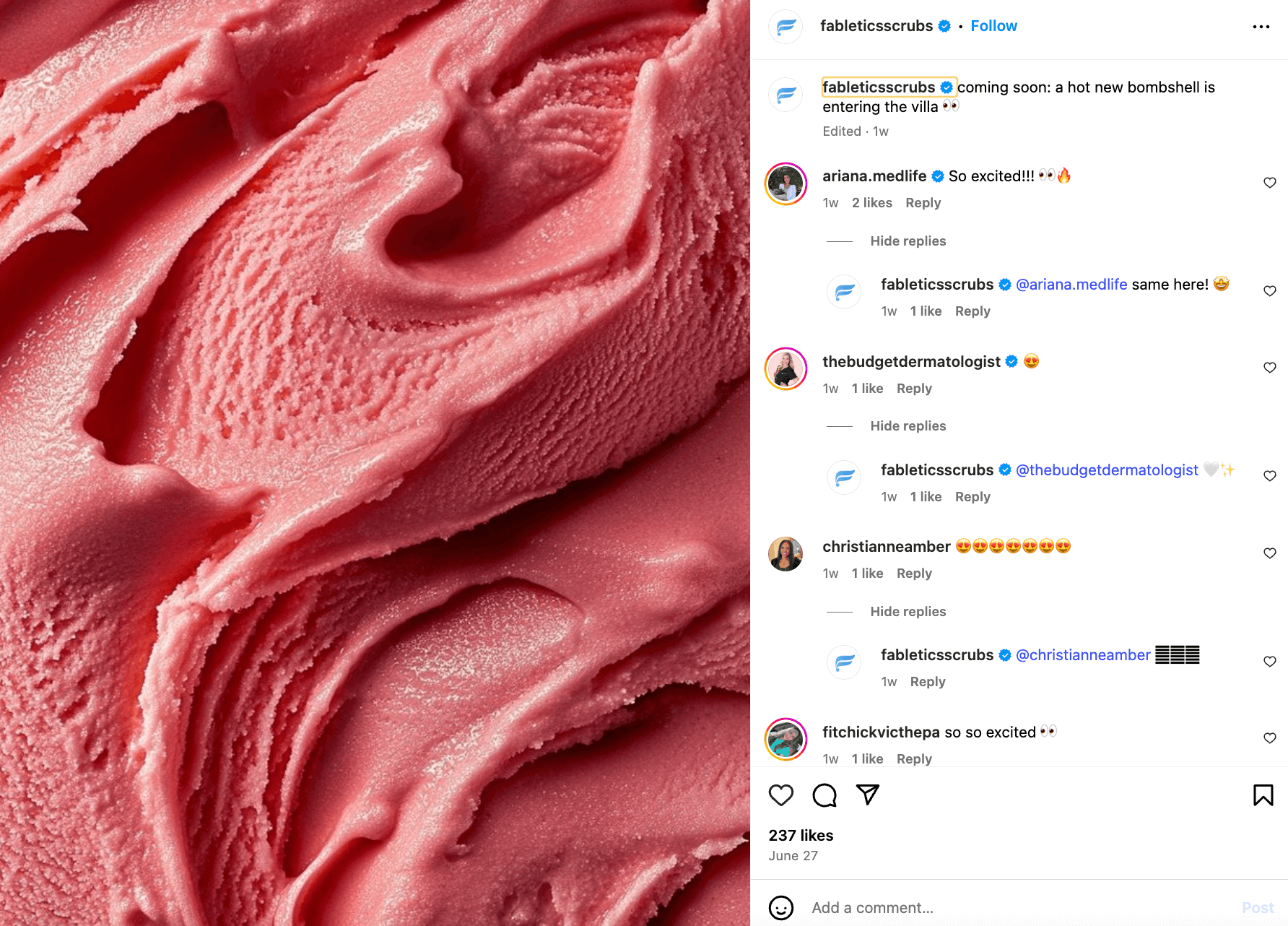
According to the 2025 Index™, consumers want brands to engage and interact with the audience. This is much more important to them than constantly posting. Additionally, they want fast and personalized customer care. Almost three-quarters (73%) will even buy from a competitor if a brand doesn’t respond on social.
But when you see hundreds of comments a day, it’s easy to miss a few. Sprout’s Smart Inbox feature helps you stay on top of all your social interactions in one place. It consolidates your comments and messages into a single, manageable stream that you can filter by network and/or profile. That way, you don’t miss a message, allowing teams to respond efficiently and build stronger follower connections.
 7. Post consistently and intentionally
7. Post consistently and intentionally
Having a consistent posting schedule is still the best way to win over the Instagram algorithm. It also helps you keep your feed fresh and retain audience attention.
At the same time, you need to be strategic with what you post. As mentioned earlier, simply churning out lots of content is no longer going to cut it.
The 2025 Content Benchmarks Report suggests that social platforms are reaching peak saturation. And posting for the sake of posting only creates noise. In other words, more posts don’t always translate to greater impact. So social media teams need to start posting less, but with more intention.
Scaling back gives you more space to create unique assets and put more thought into what you post. This human-centric content can lead to audience growth and retention.
The report indicates a growing preference for original content showing a brand’s product or service in action. This is the best type of content for getting consumers to buy from your brand. Consumers also want to see content from real customers showing the product or service in action.
Dyson excels at posting content that shows the quality and durability of its products.
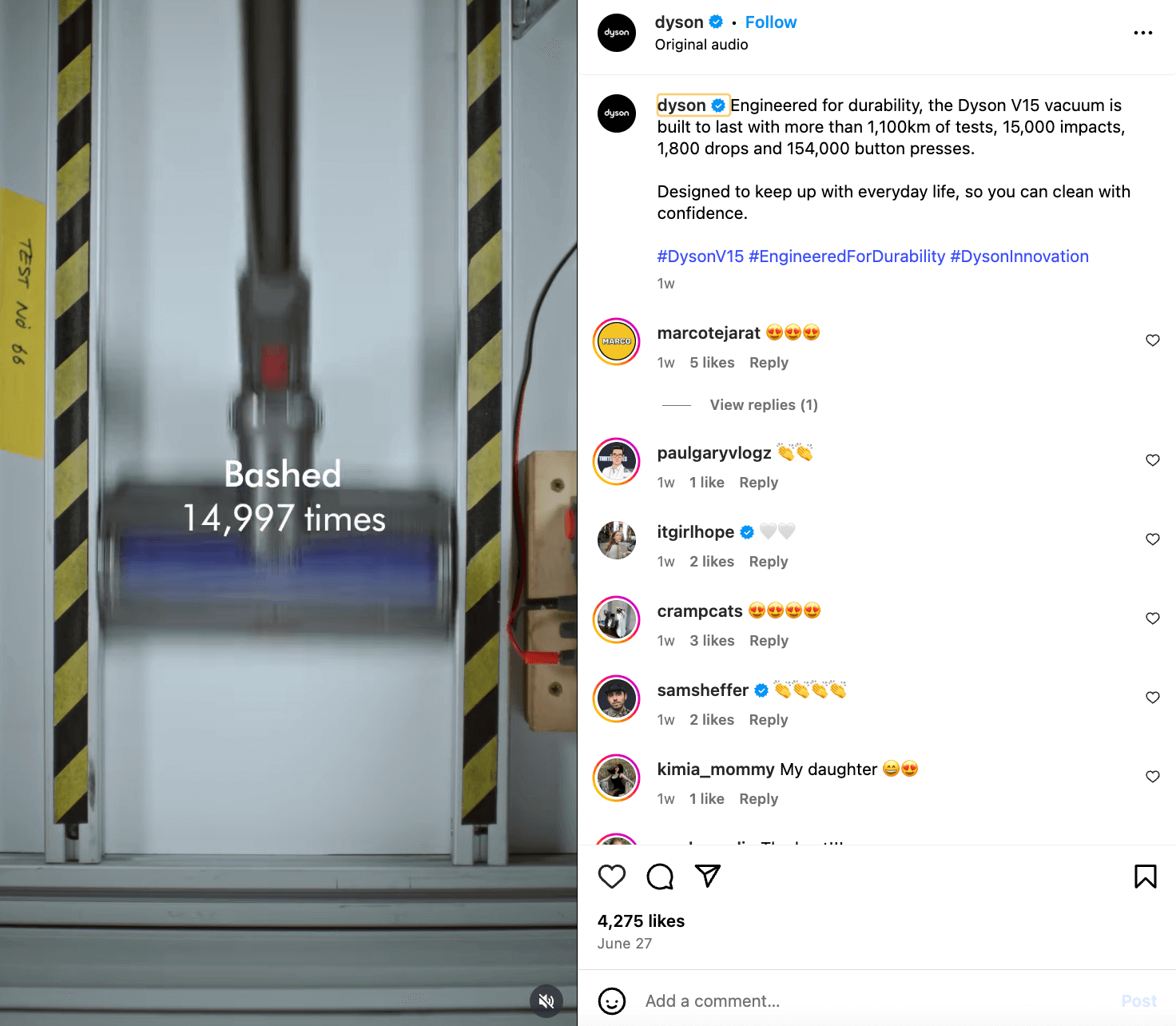
8. Partner with influencers to reach new audiences
Influencers have a massive reach over an audience that looks to them for advice and buying decisions. So collaborating with them can introduce your brand to new and relevant audiences. Influencer marketing is also an effective way to earn the trust of a strong and established audience base.
When partnering with influencers, it’s crucial that you work with people whose audience base overlaps with yours. In other words, make sure you only partner with influencers who can reach your target audience. This typically means people who’ve built an influence in your industry or a related niche.
For an even bigger impact, look for influencers leading the conversation in your industry. Use Sprout’s listening tools to identify influential voices who are already talking about topics relevant to your brand. This helps you form strategic partnerships that are more authentic and natural.
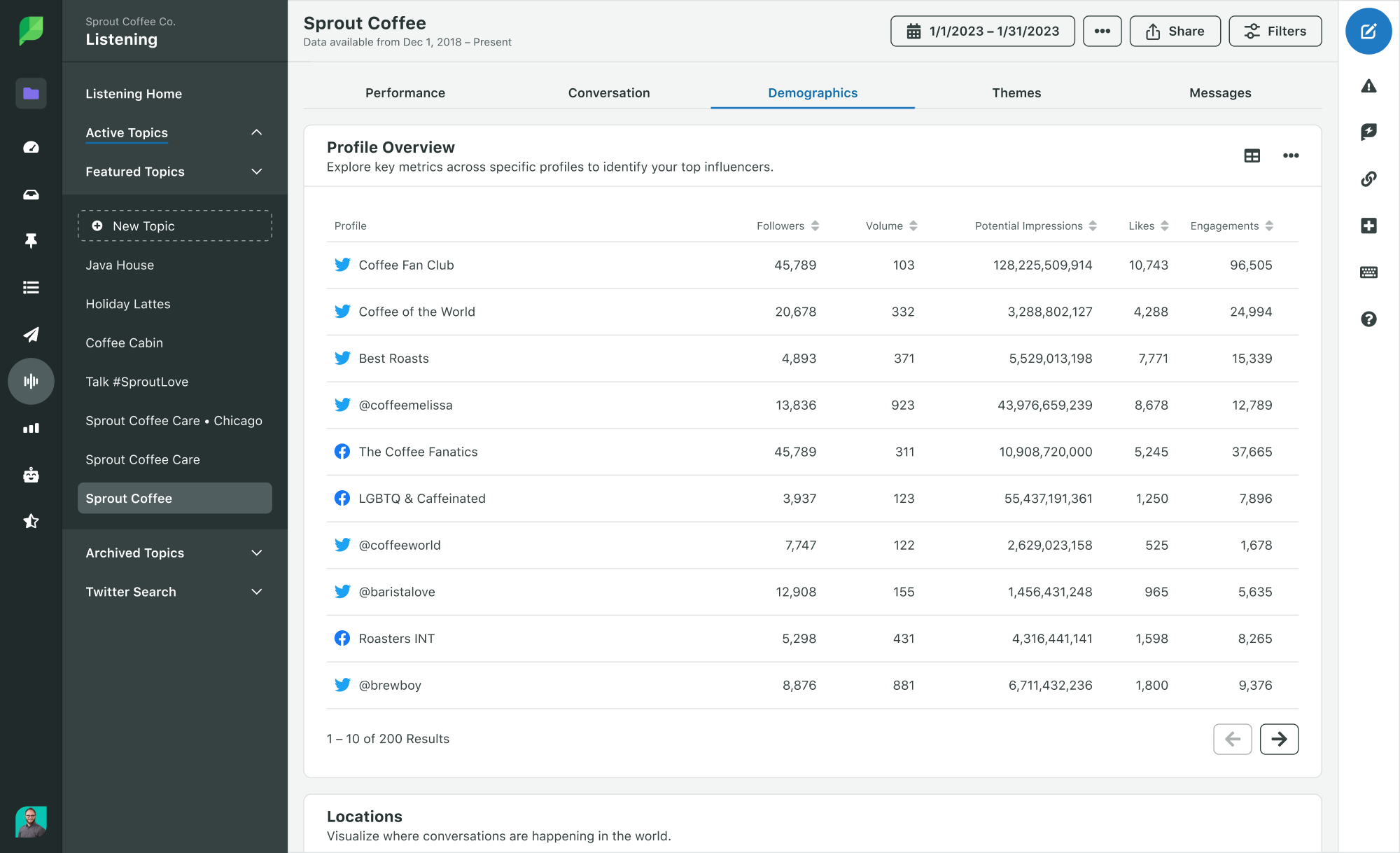
Even if you want the content to “feel” organic, don’t forget to disclose your influencer partnerships as mandated by the FTC guidelines. This reinforces transparency and authenticity, helping you boost trust with the audience.
Spoonflower partners with influential artists, decorators and seamstresses. In other words, creators who make something using the brand’s products. Every influencer discloses the partnership with an #ad tag.

Instagram best practices for strategic growth
In addition to nailing the content and social aspects of Instagram, there are also the technical considerations. Let’s look at best practices to help you sustain long-term growth on Instagram.
9. Optimize your profile with Instagram SEO
Instagram is increasingly functioning as a search engine since it now supports keyword searches. The algorithm also considers keywords when ranking content in relevant searches.
So optimizing for social search is an effective way to boost visibility on the platform.
Start by optimizing your bio with relevant keywords so it stands a better chance of showing up in search. Write more descriptive captions containing keywords that are related to the post. That said, stick to a natural flow instead of stuffing keywords. Notice the strategic use of design-related terms and keywords like “interior design” in the following caption.
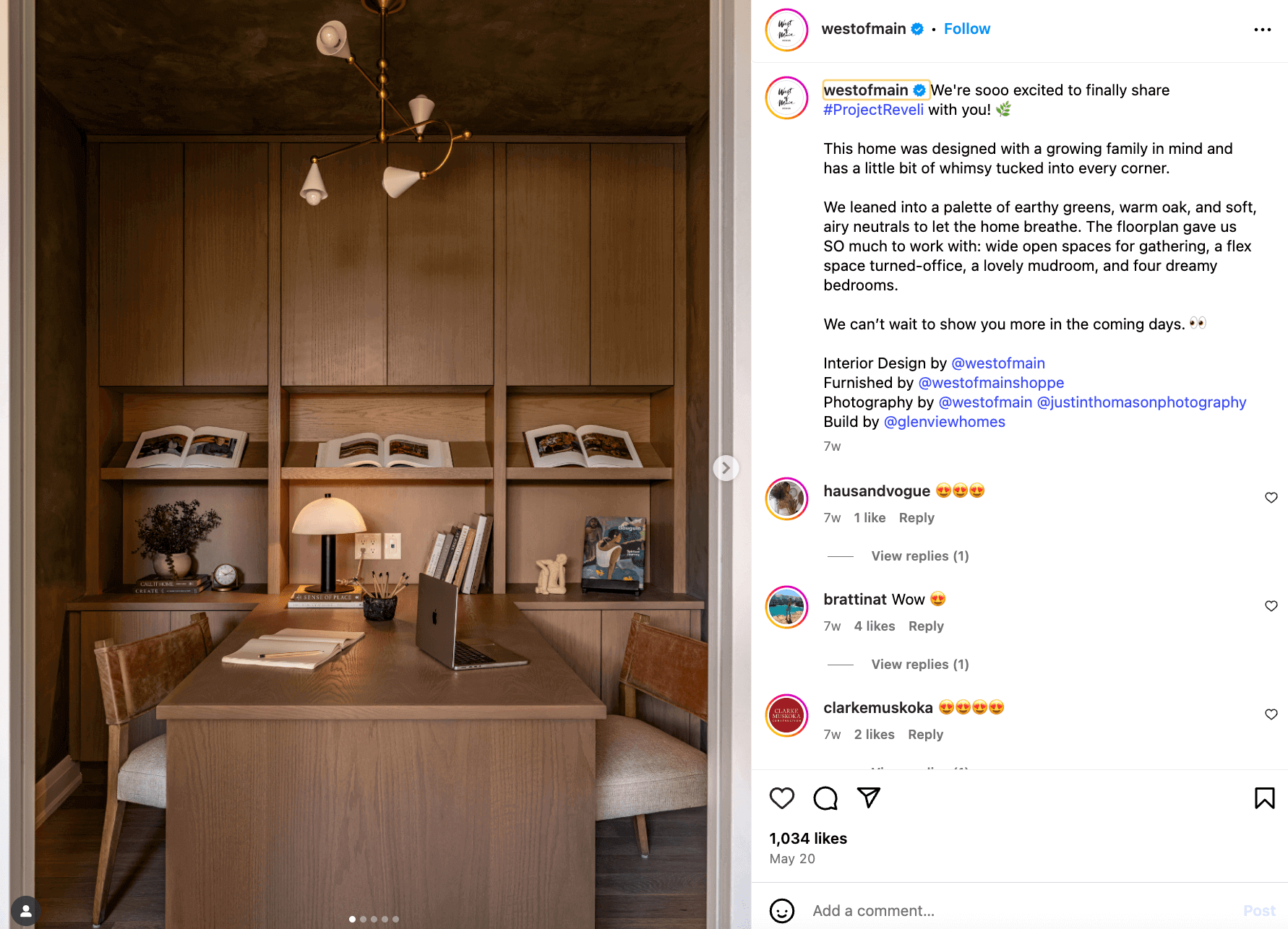
Make sure to also optimize your image alt text with keyword-rich descriptions. All of these efforts combined will help you improve discoverability.
10. Use hashtags strategically to boost discovery
Even with Instagram supporting keyword search, hashtags continue to play an important role. They help your content show up in relevant hashtag searches. Your post also stands a chance of showing up in the Explore pages of users who’ve viewed or interacted with similar content. So hashtags on Instagram are a great way to boost content discovery and overall brand visibility.
Make the most of niche hashtags and industry-related hashtags that can help you reach the right audience. Picking the most used hashtags globally or regionally may mean you just get lost in the noise. You’re more likely to get your content in front of potential customers with targeted hashtags related to your product or service.
Meanwhile, branded hashtags help you get your post in front of users specifically searching for your brand.
Nature’s Path Organic uses a mix of branded and niche hashtags in its Instagram posts. Instead of crowding up the caption, it includes the hashtags in the comments.
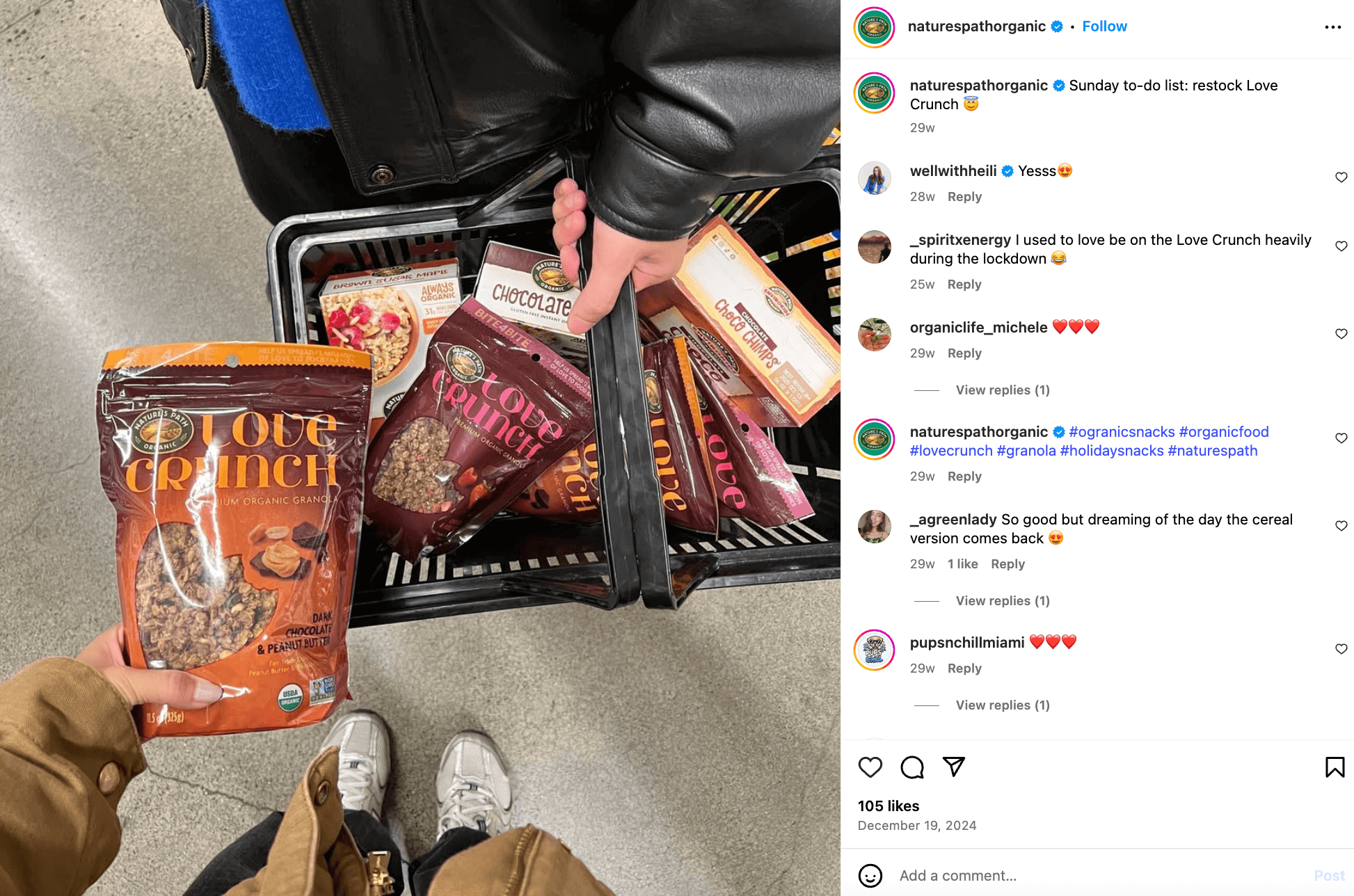
Sprout’s Instagram publishing features let you replicate this strategy with ease. While scheduling your Instagram posts, you can even schedule the first comment. This saves you and your team the time from remembering to make the first comment after a post goes live.
You can also use the hashtag reporting tool to find the best hashtag choices for each post.

11. Post when your audience is most active
The Instagram algorithm has been evolving constantly. Yet its priority on engagement remains consistent. Posting at the right times when your audience is active can translate to a boost in visibility and engagement. This is especially important now that you need to post less frequently but more intentionally.
The goal is to post your content at the right time when users are most active and most likely to engage with it. Our latest data shows that Mondays through Thursdays are the best days to post on Instagram. The peak hours are from 10 a.m. to 2 p.m.
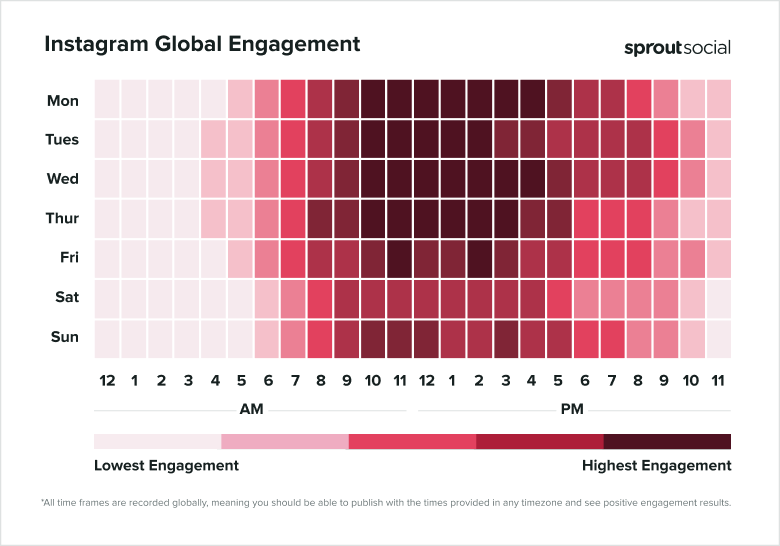
However, the specific optimal times may vary based on where you’re located, which industry you’re in and how your audience behaves.
Read our study for more industry-specific insights. And dig into your account analytics to find the optimal timing for your business in particular. You can then schedule your posts to go out on those times.
Sprout Social’s publishing tools like ViralPost offer an automated alternative to all this research. It analyzes your profile and user engagement patterns to figure out when your audience is the most active. ViralPost will then automatically push out your content at optimal send times. This streamlines your publishing efforts, enabling you to catch your audience when they’re the most engaged.

12. Adapt to new Instagram features and updates
Instagram is constantly evolving, which means brands have to always stay on top of the latest Instagram trends and features. This will give you the foresight to leverage these changes and updates ahead of your competitors.
Experiment with updates like longer carousels and longer Reels to tell more in-depth stories. Or customize your link sticker text with impactful CTAs to see what drives action. Notice how Garnier UK creates an eye-catching CTA link with emojis and discounts.
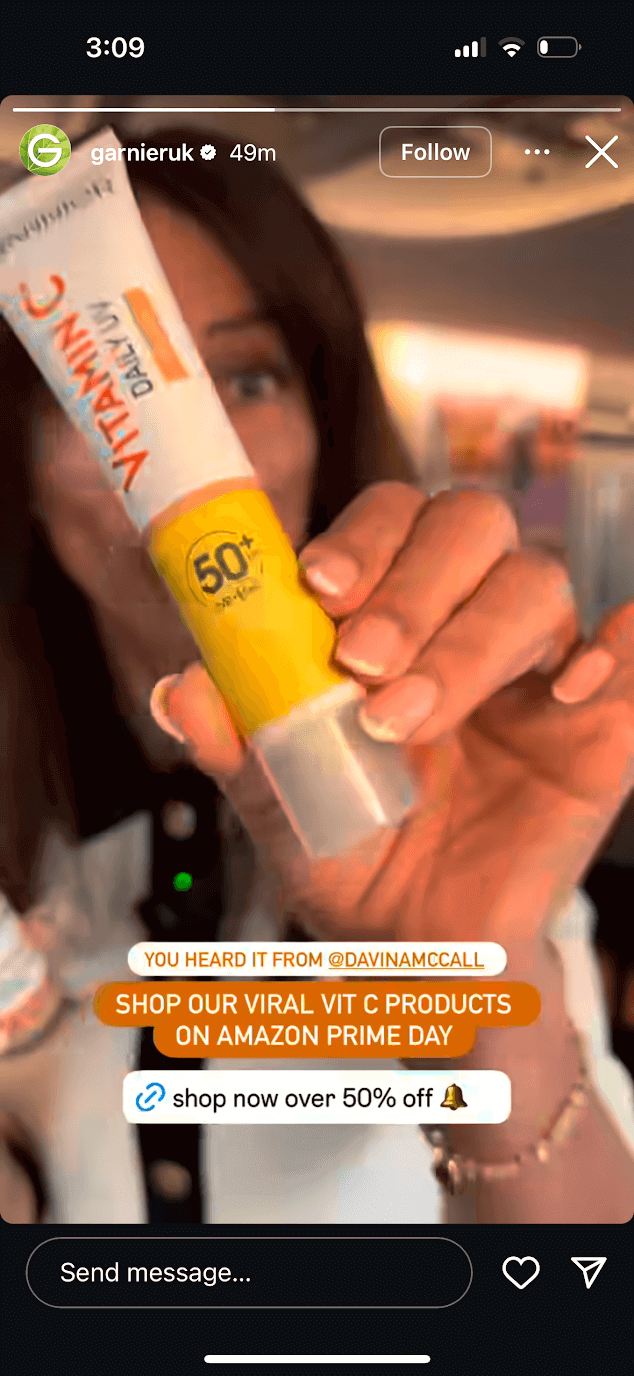
You can even add multiple links in your Instagram bio. This gives you the perfect opportunity to drive traffic to campaign landing pages and new content.
New features like broadcast channels are also an effective tool to nurture an exclusive brand community. These channels serve as a one-way messaging tool where you can share updates in the form of text and media.
Measuring and scaling your Instagram success
Building sustainable and long-term growth on Instagram is also about scaling your success. This requires using data to strategically optimize your efforts. Meanwhile, paid promotion efforts help you tackle the limitations of your organic strategy.
13. Make data-driven decisions with Instagram analytics
If you want to make Instagram work for your business, you need to let data guide your decisions. Insights about your post performance and audience engagement will show you how to improve your approach. As long as you know what to look for, data can inform your content strategy and your marketing decisions.
Here are a few ideas:
- Track comments and post performance to see how your audience is responding to a particular style of post. Then use those insights to modify your Instagram content strategy.
- Track your saves to find out which content types and topics serve the most value to your audience.
- Find out which users your target audience follows and looks up to. Then make data-driven decisions on which influencers to collaborate with.
- Monitor Instagram trends to gain foresight on how to craft timely posts, adapt your campaign or create a new one.
- Measure audience engagement to see how your campaign is performing. Then look for opportunities to improve, modify or replicate your campaign for best results.
- Instagram data analysis gives you precise insight into what’s working and what strategies aren’t taking off. This helps you figure out the best ways to continually refine your approach.
The native analytics give you basic insights to inform your strategy. But a third-party Instagram analytics tool like Sprout lets you level up your tracking.
The advanced reporting tool helps you visualize your Instagram performance across multiple profiles. It shows you post-level performance insights to help you figure out what’s working. You can even break down your performance by engagement type and profile action. So it’s easy to see which posts are driving interactions and which ones encourage action.

It also offers competitive analysis features to see how you measure up against the competition. Meanwhile, the paid performance tracking shows you how your Instagram ads are paying off. This comprehensive reporting capability makes it easier to build a data-driven strategy. It also helps you prove the social media ROI coming from Instagram.
14. Expand your reach with Instagram ads
Organic brand reach on social media is more challenging than ever with growing competition. While Instagram fares better than other major platforms, it still reports a 12% year-over-year decrease in reach.
That’s where paid ads come in, helping you promote your Instagram to a relevant target audience. Paid targeting helps you gain reach beyond current audiences who see it in their organic feeds. So you can effectively tackle the limitations of an organic approach.
Instagram advertising allows you to get your brand in front of the right people using a number of highly granular targeting options. This means you can attract new followers and new customers alike.
Make Instagram work for your brand
These Instagram best practices are the perfect starting point for brands of any size to take your account presence to the next level. And the right tool makes a world of difference in streamlining your efforts and informing your decisions.
From sending out your posts at the best times to optimizing your content strategy, Sprout can help. Try it free for 30 days and see the difference it makes.
The post Instagram best practices in 2025: Go from clicks to conversions appeared first on Sprout Social.

